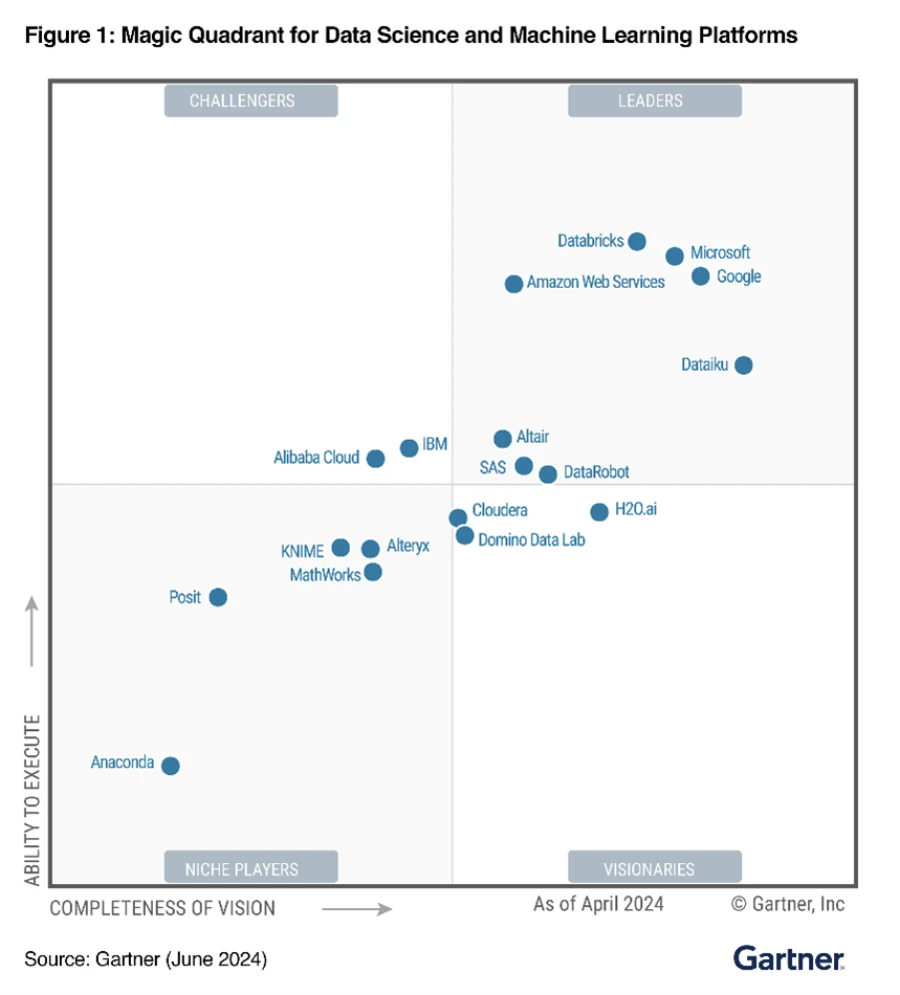Microsoft is a Leader in this year’s Gartner® Magic Quadrant™ for Data Science and Machine Learning Platforms. Azure AI provides a powerful, flexible end-to-end platform for accelerating data science and machine learning innovation while providing the enterprise governance that every organization needs in the era of AI.

In May 2024, Microsoft was also named a Leader for the fifth year in a row in the Gartner® Magic Quadrant™ for Cloud AI Developer Services, where we placed furthest for our Completeness of Vision. We’re pleased by these recognitions from Gartner as we continue helping customers, from large enterprises to agile startups, bring their AI and machine learning models and applications into production securely and at scale.
Azure AI is at the forefront of purpose-built AI infrastructure, responsible AI tooling, and helping cross-functional teams collaborate effectively using Machine Learning Operations (MLOps) for generative AI and traditional machine learning projects. Azure Machine Learning provides access to a broad selection of foundation models in the Azure AI model catalog—including the recent releases of Phi-3, JAIS, and GPT-4o—and tools to fine-tune or build your own machine learning models. Additionally, the platform supports a rich library of open-source frameworks, tools, and algorithms so that data science and machine learning teams can innovate in their own way, all on a trusted foundation.
Accelerate time to value with Azure AI infrastructure
“We’re now able to get a functioning model with relevant insights up and running in just a couple of weeks thanks to Azure Machine Learning. We’ve even managed to produce verified models in just four to six weeks.”
Dr. Nico Wintergerst, Staff AI Research Engineer at relayr GmbH
Azure Machine Learning helps organizations build, deploy, and manage high-quality AI solutions quickly and efficiently, whether building large models from scratch, running inference on pre-trained models, consuming models as a service, or fine-tuning models for specific domains. Azure Machine Learning runs on the same powerful AI infrastructure that powers some of the world’s most popular AI services, such as ChatGPT, Bing, and Azure OpenAI Service. Additionally, Azure Machine Learning’s compatibility with ONNX Runtime and DeepSpeed can help customers further optimize training and inference time for performance, scalability, and power efficiency.
Whether your organization is training a deep learning model from scratch using open source frameworks or bringing an existing model into the cloud, Azure Machine Learning enables data science teams to scale out training jobs using elastic cloud compute resources and seamlessly transition from training to deployment. With managed online endpoints, customers can deploy models across powerful CPU and graphics processing unit (GPU) machines without needing to manage the underlying infrastructure—saving time and effort. Similarly, customers do not need to provision or manage infrastructure when deploying foundation models as a service from the Azure AI model catalog. This means customers can easily deploy and manage thousands of models across production environments—from on-premises to the edge—for batch and real-time predictions.
Streamline operations with flexible MLOps and LLMOps
“Prompt flow helped streamline our development and testing cycles, which established the groundedness we required for making sure the customer and the solution were interacting in a realistic way.”
Fabon Dzogang, Senior Machine Learning Scientist at ASOS
Machine learning operations (MLOps) and large language model operations (LLMOps) sit at the intersection of people, processes, and platforms. As data science projects scale and applications become more complex, effective automation and collaboration tools become essential for achieving high-quality, repeatable outcomes.
Azure Machine Learning is a flexible MLOps platform, built to support data science teams of any size. The platform makes it easy for teams to share and govern machine learning assets, build repeatable pipelines using built-in interoperability with Azure DevOps and GitHub Actions, and continuously monitor model performance in production. Data connectors with Microsoft sources such as Microsoft Fabric and external sources such as Snowflake and Amazon S3, further simplify MLOps. Interoperability with MLflow also makes it seamless for data scientists to scale existing workloads from local execution to the cloud and edge, while storing all MLflow experiments, run metrics, parameters, and model artifacts in a centralized workspace.
Azure Machine Learning prompt flow helps streamline the entire development cycle for generative AI applications with its LLMOps capabilities, orchestrating executable flows comprised of models, prompts, APIs, Python code, and tools for vector database lookup and content filtering. Azure AI prompt flow can be used together with popular open-source frameworks like LangChain and Semantic Kernel, enabling developers to bring experimental flows into prompt flow to scale those experiments and run comprehensive evaluations. Developers can debug, share, and iterate on applications collaboratively, integrating built-in testing, tracing, and evaluation tools into their CI/CD system to continually reassess the quality and safety of their application. Then, developers can deploy applications when ready with one click and monitor flows for key metrics such as latency, token usage, and generation quality in production. The result is end-to-end observability and continuous improvement.
Develop more trustworthy models and apps
“The responsible AI dashboard provides valuable insights into the performance and behavior of computer vision models, providing a better level of understanding into why some models perform differently than others, and insights into how various underlying algorithms or parameters influence performance. The benefit is better-performing models, enabled and optimized with less time and effort.”
—Teague Maxfield, Senior Manager at Constellation Clearsight
AI principles such as fairness, safety, and transparency are not self-executing. That’s why Azure Machine Learning provides data scientists and developers with practical tools to operationalize responsible AI right in their flow of work, whether they need to assess and debug a traditional machine learning model for bias, protect a foundation model from prompt injection attacks, or monitor model accuracy, quality, and safety in production.
The Responsible AI dashboard helps data scientists assess and debug traditional machine learning models for fairness, accuracy, and explainability throughout the machine learning lifecycle. Users can also generate a Responsible AI scorecard to document and share model performance details with business stakeholders, for more informed decision-making. Similarly, developers in Azure Machine Learning can review model cards and benchmarks and perform their own evaluations to select the best foundation model for their use case from the Azure AI model catalog. Then they can apply a defense-in-depth approach to mitigating AI risks using built-in capabilities for content filtering, grounding on fresh data, and prompt engineering with safety system messages. Evaluation tools in prompt flow enable developers to iteratively measure, improve, and document the impact of their mitigations at scale, using built-in metrics and custom metrics. That way, data science teams can deploy solutions with confidence while providing transparency for business stakeholders.
Read more on Responsible AI with Azure.
Deliver enterprise security, privacy, and compliance
“We needed to choose a platform that provided best-in-class security and compliance due to the sensitive data we require and one that also offered best-in-class services as we didn’t want to be an infrastructure hosting company. We chose Azure because of its scalability, security, and the immense support it offers in terms of infrastructure management.”
—Michael Calvin, Chief Technical Officer at Kinectify
In today’s data-driven world, effective data security, governance, and privacy require every organization to have a comprehensive understanding of their data and AI and machine learning systems. AI governance also requires effective collaboration between diverse stakeholders, such as IT administrators, AI and machine learning engineers, data scientists, and risk and compliance roles. In addition to enabling enterprise observability through MLOps and LLMOps, Azure Machine Learning helps organizations ensure that data and models are protected and compliant with the highest standards of security and privacy.
With Azure Machine Learning, IT administrators can restrict access to resources and operations by user account or groups, control incoming and outgoing network communications, encrypt data both in transit and at rest, scan for vulnerabilities, and centrally manage and audit configuration policies through Azure Policy. Data governance teams can also connect Azure Machine Learning to Microsoft Purview, so that metadata on AI assets—including models, datasets, and jobs—is automatically published to the Microsoft Purview Data Map. This enables data scientists and data engineers to observe how components are shared and reused and examine the lineage and transformations of training data to understand the impact of any issues in dependencies. Likewise, risk and compliance professionals can track what data is used to train models, how base models are fine-tuned or extended, and where models are employed across different production applications, and use this as evidence in compliance reports and audits.
Lastly, with the Azure Machine Learning Kubernetes extension enabled by Azure Arc, organizations can run machine learning workloads on any Kubernetes clusters, ensuring data residency, security, and privacy compliance across hybrid public clouds and on-premises environments. This allows organizations to process data where it resides, meeting stringent regulatory requirements while maintaining flexibility and control over their MLOps. Customers using federated learning techniques along with Azure Machine Learning and Azure confidential computing can also train powerful models on disparate data sources, all without copying or moving data from secure locations.
Get started with Azure Machine Learning
Machine learning continues to transform the way businesses operate and compete in the digital era—whether you want to optimize your business operations, enhance customer experiences, or innovate. Azure Machine Learning provides a powerful, flexible machine learning and data science platform to operationalize AI innovation responsibly.
- Read the 2024 Gartner® Magic Quadrant™ for Data Science and Machine Learning Platforms report.
- Learn more about Microsoft’s placement in the blog post “Gartner® Magic Quadrant™ for Cloud AI Developer Services.”
- Explore more on the Microsoft Customer Stories blog.
*Gartner, Magic Quadrant for Data Science and Machine Learning Platforms, By Afraz Jaffri, Aura Popa, Peter Krensky, Jim Hare, Raghvender Bhati, Maryam Hassanlou, Tong Zhang, 17 June 2024.
Gartner, Magic Quadrant for Cloud AI Developer Services, Jim Scheibmeir, Arun Batchu, Mike Fang, Published 29 April 2024.
GARTNER is a registered trademark and service mark of Gartner, Inc. and/or its affiliates in the U.S. and internationally, Magic Quadrant is a registered trademark of Gartner, Inc. and/or its affiliates and is used herein with permission. All rights reserved.
Gartner does not endorse any vendor, product or service depicted in its research publications and does not advise technology users to select only those vendors with the highest ratings or other designation. Gartner research publications consist of the opinions of Gartner’s Research & Advisory organization and should not be construed as statements of fact. Gartner disclaims all warranties, expressed or implied, with respect to this research, including any warranties of merchantability or fitness for a particular purpose.
This graphic was published by Gartner, Inc. as part of a larger research document and should be evaluated in the context of the entire document. The Gartner document is available upon request from this link.

